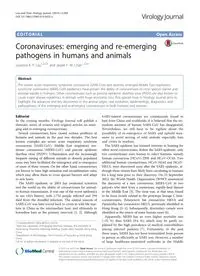
2015 Coronaviruses_ emerging and re-emerging pathogens in humans and animals PDF
Preview 2015 Coronaviruses_ emerging and re-emerging pathogens in humans and animals
EDITORIAL Open Access Coronaviruses: emerging and re-emerging pathogens in humans and animals Susanna K. P. Lau1,2,3,4* and Jasper F. W. Chan1,2,3,4 Abstract The severe acute respiratory syndrome coronavirus (SARS-CoV) and recently emerged Middle East respiratory syndrome coronavirus (MERS-CoV) epidemics have proven the ability of coronaviruses to cross species barrier and emerge rapidly in humans. Other coronaviruses such as porcine epidemic diarrhea virus (PEDV) are also known to cause major disease epidemics in animals wiith huge economic loss. This special issue in Virology Journal aims to highlight the advances and key discoveries in the animal origin, viral evolution, epidemiology, diagnostics and pathogenesis of the emerging and re-emerging coronaviruses in both humans and animals. Editorial In the coming months, Virology Journal will publish a thematic series of reviews and original articles on emer- ging and re-emerging coronaviruses. Several coronaviruses have caused serious problems in humans and animals in the past two decades. The best known examples are severe acute respiratory syndrome coronavirus (SARS-CoV), Middle East respiratory syn- drome coronavirus (MERS-CoV) and porcine epidemic diarrhea virus (PEDV). Urbanization and the increasingly frequent mixing of different animals in densely populated areas may have facilitated the emergence and re-emergence of some of these viruses. On the other hand, coronaviruses are known to have high mutation and recombination rates, which may allow them to cross species barriers and adapt to new hosts. The SARS epidemic in 2003 has awakened scientists and the world on the ability of coronaviruses for animal- to-human transmission. It was one of the worst epidemics in our city’s history, with 1,755 people infected and 299 died from the dreadful infection. The animal sources of SARS-CoV was later traced back to civets in wild life mar- kets in China as the intermediate host, and ultimately to horseshoe bats as the primary reservoir [1, 2]. Although SARS-related coronaviruses are continuously found in bats from China and worldwide, it is believed that the im- mediate ancestor of human SARS-CoV has disappeared. Nevertheless, we still have to be vigilant about the possibility of re-emergence of SARS and uphold mea- sures to avoid mixing of wild animals especially bats and civets in markets. The SARS epidemic has boosted interests in hunting for other novel coronaviruses. Before the SARS epidemic, only two coronaviruses were known to infect humans, namely human coronavirus (HCoV)-229E and HCoV-OC43. Two additional human coronaviruses, HCoV-NL63 and HCoV- HKU1, were discovered soon after the SARS epidemic, al- though these viruses have likely been circulating in humans for a long time prior to their discovery. On 23 September 2012, the World Health Organization (WHO) announced the discovery of a new coronavirus, MERS-CoV, in two patients who died from a mysterious, rapidly-fatal disease in the Middle East [3]. The virus was, at that time, found to be most closely related to the prototype lineage C beta- coronaviruses, Tylonycteris bat coronavirus HKU4 and Pipistrellus bat coronavirus HKU5, previously identified in Hong Kong [3–5]. Subsequently, dromedary camels were identified as the source of some human cases [6]. Apparently, MERS has an even higher mortality rate (>35 %) than SARS (9.6 %), which may be partly ex- plained by the high prevalence of medical comorbidities among infected patients [7]. Fortunately, in the past three years, MERS has not been transmitted from person to person as efficiently as SARS was. However, a number of large healthcare-associated outbreaks in the Middle * Correspondence:
